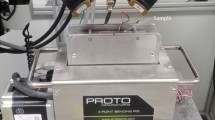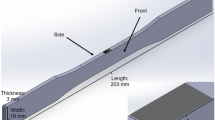Abstract
The 3D image correlation technique is used for full field measurement of strain (and strain rate) in compression and tensile split Hopkinson bar experiments using commercial image correlation software and two digital high-speed cameras that provide a synchronized stereo view of the specimen. Using an array of 128 × 80 (compression tests) and 258 × 48 (tensile tests) pixels, the cameras record about 110,000 frames per second. A random dot pattern is applied to the surface of the specimens. The image correlation algorithm uses the dot pattern to define a field of overlapping virtual gage boxes, and the 3-D coordinates of the center of each gage box are determined at each frame. The coordinates are then used for calculating the strains throughout the surface of the specimen. The strains determined with the image correlation method are compared with those determined from analyzing the elastic waves in the bars, and with strains measured with strain gages placed on the specimens. The system is used to study the response of OFE C10100 copper. In compression tests, the image correlation shows a nearly uniform deformation which agrees with the average strain that is determined from the waves in the bars and the strains measured with strain gages that are placed directly on the specimen. In tensile tests, the specimen geometry and properties affect the outcome from the experiment. The full field strain measurement provides means for examining the validity and accuracy of the tests. In tests where the deforming section of the specimen is well defined and the deformation is uniform, the strains measured with the image correlation technique agree with the average strain that is determined from the split Hopkinson bar wave records. If significant deformation is taking place outside the gage section, and when necking develops, the strains determined from the waves are not valid, but the image correlation method provides the accurate full field strain history.























Similar content being viewed by others
References
Kolsky H (1949) An investigation of the mechanical properties of materials at very high rates of loading. Proc Phys Soc, London 62-B:676–700.
Gray GT (2000) “Classic Split-Hopkinson Pressure Bar Testing,” ASM Handbook, Vol. 8, Mechanical Testing and Evaluation, ASM International, Materials Park, Ohio, 462–476.
Kahn-Jetter ZL, Chu TC (1990) 3-D displacement measurements using digital image correlation and photogrammetry techniques. Exp Mech 301:10–16.
Helm JD, McNeill SR, Sutton MA (1996) Improved three-dimensional image correlation for surface displacement measurement. Opt Engr 357:1911–1920.
Staab GH, Gilat A (1991) A direct-tension split Hopkinson bar for high strain rate testing. Exp Mech 313:232–235.
Acknowledgement
The research reported in this paper was supported by the U.S. Air Force SBIR contracts FA8651-05-C-0223 and FA8651-06-C-0123. The technical sponsor is Dr. Joel House and the technical monitor is Mr. Philip Flater. Thanks to Mr. Jeremy Seidt for the useful technical discussions and to Gary Gardner for specimen and adaptor machining.
Author information
Authors and Affiliations
Corresponding author
Rights and permissions
About this article
Cite this article
Gilat, A., Schmidt, T.E. & Walker, A.L. Full Field Strain Measurement in Compression and Tensile Split Hopkinson Bar Experiments. Exp Mech 49, 291–302 (2009). https://doi.org/10.1007/s11340-008-9157-x
Received:
Accepted:
Published:
Issue Date:
DOI: https://doi.org/10.1007/s11340-008-9157-x




